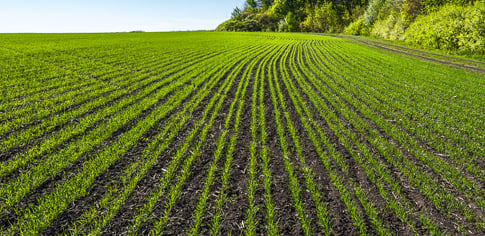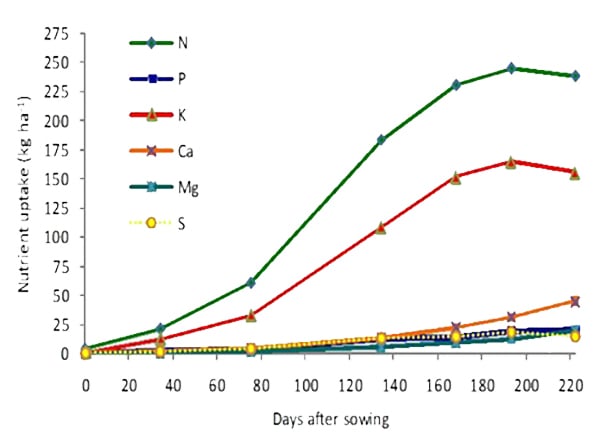Growing Wheat crop nutrition advice
Everything you need to know about wheat fertilization, best practices, suitable products, field trials and more
Advice for growing Wheat (Triticum spp.)
-
Optimal pH for winter wheat is 6.5.
-
Yields of most cultivars can be markedly reduced where pH is below 5.5, mainly due to susceptibility to P, Mo and Ca deficiencies.
-
In pH >7.5 deficiencies of B, Cu, Fe, Mn, P and Zn are likely to appear. Wheat can be grown on practically all soil types.
-
The great plain region, in the US, offers favorable growing conditions for wheat, including rich soils, sufficient rainfall or irrigation, and a semi-arid climate conducive to wheat cultivation
-
The most favorable temperature for flowering, grain initiation, grain formation, and maturing is at 68–77 °F.

Healty winter wheat at growing stage

Wheat field close-up
Growing wheat in the US
The geographic diversity, crop rotation practices, technology adoption and advanced farming practices makes the US a dynamic and vital component of the global agricultural landscape. Growing wheat commercially in the US involves unique approaches to nutrient management and fertilizer usage, primarily due to the diverse growing conditions and farming practices employed across different regions.
- Soil Variability: Wheat is grown in a wide range of soil types across the US, including loam, clay, and sandy soils, each with its nutrient-holding capacity and pH levels. Consequently, nutrient management practices must be tailored to address specific soil characteristics to optimize wheat yields.
- Crop Rotation: Wheat is often part of a crop rotation system with other crops like corn, soybeans, or cotton. This rotation helps manage soil fertility and reduces the risk of nutrient depletion. For example, leguminous crops in rotation with wheat can contribute nitrogen to the soil through biological nitrogen fixation, reducing the need for synthetic nitrogen fertilizers.
- Nitrogen Management: Nitrogen is a crucial nutrient for wheat growth and yield. Commercial wheat growers in the US employ various nitrogen management practices, such as soil testing, pre-plant nitrogen application, split applications, and the use of nitrogen-fixing cover crops to optimize nitrogen availability to wheat while minimizing environmental impacts such as nitrate leaching. Polysulphate (polyhalite), a gradual-release fertilizer, has also been shown to improve nitrogen use efficiency (NUE), and boost wheat yields
- Phosphorus and Potassium: Phosphorus and potassium are essential nutrients for wheat, contributing to root development, stress tolerance, and grain filling. Soil testing is used to determine phosphorus and potassium levels, and fertilization practices are adjusted accordingly to meet the crop’s requirements.
- Foliar Fertilizer Blends: ICL’s commercial foliar fertilizers are formulated with a combination of nutrients, including nitrogen, phosphorus, potassium, and micronutrients. Products like Nova Pulse and Nova Finish are designed to provide a balanced nutrient supply and address multiple nutrient deficiencies simultaneously.
- Sustainability Practices: Many wheat growers in the US are adopting sustainable nutrient management practices to lower carbon footprints, enhance soil health, reduce nutrient runoff, and minimize environmental impacts. This includes the use of organic amendments, cover cropping, conservation tillage, and nutrient management planning to improve nutrient cycling and reduce fertilizer inputs.
What soil type, pH and climate does wheat prefer?
Wheat thrives in regions with well-drained loam or clay loam soils, slightly acidic to neutral soil pH.
- Wheat favours well-drained soils with good water retention capabilities, making loam and clay loam soils preferred choices. While these soils retain moisture and allow for adequate drainage, wheat can also grow in sandy soils with proper irrigation and management.
- The ideal pH for wheat typically ranging from 6.0 to 7.5 (slightly acidic to neutral soil pH levels). Maintaining soil pH within this range ensures optimal nutrient availability for wheat plants.
- Wheat grows best in regions with temperate climates characterized by distinct seasons.
- Cool temperatures during the early growth stages and warmer temperatures during later stages for grain filling.
- A cold winter period is often necessary for vernalization, which is crucial for proper flowering and grain development in wheat.
Nutrient requirements
Estimated nutrient uptake (kg/ha):
| Variety | Yield | N lbs/acre | P2O5 lbs/acre | K2O lbs/acre |
|---|---|---|---|---|
| Winter wheat | Total biomass: 6.1 tons/acre Yield: 100 bushels/acre | 167 116 | 49 35 | 225 46 |
| Spring wheat | Total biomass: 4.0 tons/acre Yield: 67 bushels/acre | 115 89 | 52 45 | 112 22 |
*Whole above-ground part of plant
Source: Adapted from Aigner et al., 1988
Dynamic of nutrient uptake over a crop season in wheat

Reference: Hirzel and Undurraga, 2013
Role of nutrients
| Key parameter | N | P2O5 | K2O | Mg | C | S |
|---|---|---|---|---|---|---|
| Yield | +++ | + | ++ | + | + | + |
| Protein content | +++ | + | ++ | + | +++ | |
| Vegetative growth | +++ | + | + | ++ | + | + |
| Root system | + | +++ | + | ++ |
+ = improving
– = decreasing
+/- = different results, depending on the rate of nutrient applied
Source: IPI bulletin – Cereals
Source: Whinter wheat – Crop advice sheet (Agronomy Campus)
Nutrient deficiencies
| Nutrient | Description | |
|---|---|---|
| Nitrogen | Plants are pale green to yellow with chlorosis beginning on lower leaves and progressing upwards as the deficiency intensifies; plants have spindly stems and growth is slow. | |
| Phosphorus | P deficient plants may remain darker green than normal plants and develop purple discoloration first on the underside and later throughout. Leaf tips may die back when P deficiency is severe. Plants grow slowly, stems are thin and shortened and maturity is delayed. P deficient plants also exhibit poor tillering. | |
| Potassium | K deficiency is initially manifested as chlorosis on the older leaves and progresses upwards as the deficiency intensifies. .The leaves eventually become streaked and take on a scorched appearance along the leaf margins. Chlorotic areas may develop throughout the leaf. Deficiency symptoms can occur in young leaves of some fast-maturing high-yielding varieties. Stems of deficient plants are weak and tend to lodge. | |
| Sulfur | Symptoms are similar to nitrogen deficiency, but the chlorosis is uniform and general, throughout the entire plant, including younger leaves. Sulfur deficiency is most likely on sandy, free draining and soils low in organic matter. | |
| Calcium | Ca deficiency is very rare on small grains. Plants are severely stunted, and new leaves exude a gelatinous-like material, causing new leaves to stick together. Because Ca deficiency is favored by low pH (<5.2) and low soil Ca, aluminum-, and manganese- toxicity symptoms will usually be exhibited before Ca deficiency symptoms. | |
| Magnesium | Typically, Mg deficiency is found on soils with a pH of less than about 5.2. Also, wheat is unable to absorb adequate Mg in cool, wet springs. |
|
| Zinc | Cereals Zn deficiency generally shows up in early growth stages, when plant is only ~10 cm high, appearing first as yellow streaks in the young leaves, with a white to yellowish tip. White spots often appear on the leaves, or along their edges, and a portion of the marginal area may die. The entire plant is frequently stunted. | |
| Boron | Terminal shoots die. Leaves die back from tips, and young leaves remain rolled. (Similar to calcium deficiency) B- deficient plants produce very thin ears with much reduced grain yield. | |
| Copper | Cu deficiency tends to appear in the youngest leaves. Leaf twisting and white leaf tipping. Severe yield reduction. Copper deficiency may be due to low soil availability, or low total soil copper, and is problematic on light, acidic soils, low soil organic matter, granite parent materials, and dry soil. | |
| Iron | Iron deficiency starts out as an interveinal chlorosis of the youngest leaves, evolves into an overall chlorosis, and ends as a die-back of the chlorotic leaves. | |
| Manganese | At early stages, light chlorosis appears on the young leaves. At more severe cases, mature leaves show netted veins. Then leaves develop brown-grey necrosis along the veins. Chlorotic flecks pattern, concentrated mainly at the leaf base. |
Source: https://vikaspedia.in
The influence of nutrient for wheat resistance
| Disease | Pathogen | Increase resistant | Decrease resistant |
|---|---|---|---|
| Roots: | |||
| Take-all disease | Gaeumannomyces graminis var. tritici | N-NH4, Mn, Cu, Cl | N-NO3 |
| Fusariosis | Fusarium ssp. | Zn, Cl | K |
| Leaves: | |||
| Powdery mildew of cereales | Erysiphe graminis | K, S, Mn | N, Zn |
| Black stem rust | Puccinia graminis | K, S | |
| Brown rust | Puccinia recondite f. sp. Tritici | K, Mn, Cl | Cu |
| Septoria tritici | K, Cl | P | |
Source: Datnoff L., Elmer W., Huber D., 2007: Mineral nutrition and plant disease, ASP Press, St. Paul, USA, 278 s.
Overall, nutrient management and fertilizer practices in commercial wheat production in the US are continually evolving, driven by factors such as soil variability, crop rotation, advances in technology, sustainability goals, and research-based recommendations, all aimed at enhancing productivity and environmental stewardship. It’s important for wheat growers to carefully consider their specific nutrient needs based on soil tests, tissue analyses, and crop observations before selecting and applying fertilizers. Additionally, proper application timing, rates, and methods should be followed to maximize effectiveness and minimize the risk of nutrient imbalances or phytotoxicity.












